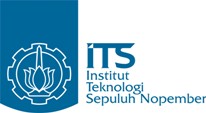Study and Analysis of the Performance of the Propulsion System of the K-61 Type Amphibious Vehicle for Artillery Transport (KAPA)
Abstract
The application of waterjet propulsion systems in amphibious combat vehicles, such as the KAPA Type K-61 used by the Indonesian National Armed Forces (TNI) for transporting artillery munitions, is crucial for enhancing operational performance. The working principle of a waterjet involves drawing water from beneath the vehicle's hull, accelerating it through a pump, and expelling it to generate thrust. The design of the waterjet propulsion system significantly impacts the thrust produced. This study aims to evaluate the maximum performance achievable by the waterjet propulsion system of the KAPA Type K-61. The analysis is conducted using various Index Velocity Ratio (IVR) values, including IVR 0.28, which represents the current speed of the KAPA Type K-61, and other variations such as IVR 0.54, 0.59, 0.67, 0.70, 0.78, 0.94, 1.18, 1.64, and 2.38. The analysis results include the thrust value produced at the waterjet outlet, efficiency, and propulsion power. The study found that at an IVR of 2.38, the system produced the highest thrust of 30.72 N, with a propulsion power of 7315.13 Watts, equivalent to 9.95 Horsepower, and the highest efficiency of 99.21%. Based on the research conducted, it is recommended that future studies create a geometric model of the KAPA Type K-61 with original and more detailed dimensions and perform a 1:1 scale analysis to strengthen the obtained results. Additionally, analyzing the waterjet propulsion system along with the impeller or propeller system is also suggested to gain a more comprehensive understanding of the overall propulsion system's performance and efficiency.
Keywords
Full Text:
PDFReferences
Suwandi A, Purwantoro SA, Amperiawan G, Aritonang S. Kajian Teramekanika Pendaratan Kendaraan Amphibious Rig M3 Pada Tepian Sungai Terjal Dan Jenis Lempung Melalui Studi Kasus Latihan Di Gedebage Bandung Terramechanical Study of Amphibious Rig M3 Vehicle Landing on Steep Riverbanks and Clay Types Through a . J Teknol Daya Gerak [Internet]. 2022;5(1):18–30. Available from: https://www.gdels.com/m3.php
Neviana O, Satrya C. Desain structure chassis kapal di aplikasikan pada chassis KAPA ( kendaraan Amfibi Pengangkut Arteleri ) SHIP DESIGN CHASSIS STRUCTURE IS APPLIED ON THE CHASSIS KAPA ( KENDARAAN AMFIBI PENGANGKUT ARTELERI ). 2016;
Helvacioglu S, Helvacioglu IH, Tuncer B. Improving the river crossing capability of an amphibious vehicle. Ocean Eng [Internet]. 2011;38(17–18):2201–7. Available from: http://dx.doi.org/10.1016/j.oceaneng.2011.10.001
Gong J, Wu Z, Ding J, Jiang J, Zhang Z. Numerical analysis of propulsion performance of a waterjet-propelled vehicle in steady drift. Ocean Eng [Internet]. 2022;266(P4):113136. Available from: https://doi.org/10.1016/j.oceaneng.2022.113136
T. Katsoulis, X. Wang, and P. D. Kaklis, “A ..T-splines-based.. parametric.. modeller.. for.. computer..-aided.. ship design,” Ocean Engineering, vol. 191, Nov. 2019, doi: 10.1016/j.oceaneng.2019.106433.
Jiao W, Cheng L, Zhang D, Zhang B, Su Y, Wang C. Optimal Design of Inlet Passage for Waterjet Propulsion System Based on Flow and Geometric Parameters. Adv Mater Sci Eng. 2019;2019.
Jiang J, Ding J, Lyu N, Luo H, Li L. Control volume determination for submerged waterjet system in self-propulsion. Ocean Eng [Internet]. 2022;265(April):112594. Available from: https://doi.org/10.1016/j.oceaneng.2022.112594
Fujisawa N. Measurements of Basic Performances for Waterjet Propulsion Systems in Water Tunnel. Int J Rotating Mach. 1995;2(1):43–50.
Budiyanto MA, Ayuningtyas H. PERFORMANCE ANALYSIS of WATERJET PROPULSION on AN UNMANNED SURFACE VEHICLE MODEL. J Appl Eng Sci. 2021;19(4):886–95.
Roberts L. Statement of originality. Prot Promot Client Rights. 2021;(February 1998):xiii.
Cao P, Wang Y, Kang C, Li G, Zhang X. Investigation of the role of non-uniform suction flow in the performance of water-jet pump. Ocean Eng [Internet]. 2017;140(March 2016):258–69. Available from: http://dx.doi.org/10.1016/j.oceaneng.2017.05.034
Van Esch BPM, Bulten NWH. Numerical and experimental investigation of hydrodynamic forces due to non-uniform suction flow to a mixed-flow pump. Proc 2005 ASME Fluids Eng Div Summer Meet FEDSM2005. 2005;2005:1236–42.
Van Terwisga T, Ranocchia D, Hoyt JG, Aartojarvi R, Chun HHC, Semionycheva E, et al. Report of the Specialist Committee on Validation of Waterjet Test Procedures. 24th ITTC. 2005;II.
Coop HG. Investigation of hull-waterjet interaction effects. 1995;
Guo J, Chen Z, Dai Y. Numerical study on self-propulsion of a waterjet propelled trimaran. Ocean Eng [Internet]. 2020;195(October 2019):106655. Available from: https://doi.org/10.1016/j.oceaneng.2019.106655
Zhang L, Zhang JN, Shang YC, Dong GX, Chen WM. A Practical approach to the assessment of waterjet propulsion performance: The case of a waterjet-propelled trimaran. Polish Marit Res. 2020;26(4):27–38.
Stern F, Wilson R V, Coleman HW, Paterson EG, N--- G, N--- G, et al. Verification and validation of CFD simulations. 1999;(407).
Han W, Shang T, Su M, Gong C, Li R, Meng B. Direct sailing variable acceleration dynamics characteristics of water-jet propulsion with a screw mixed-flow pump. Appl Sci. 2019;9(19).
Zhang Z, Cao S, Shi W, Luo X, Wang H, Deng J, et al. High pressure waterjet propulsion with thrust vector control system applied on underwater vehicles. Ocean Eng [Internet]. 2018;156(March):456–67. Available from: https://doi.org/10.1016/j.oceaneng.2018.03.009
© ANSYS rights reserved. Ansys Fluent: Fluid Simulation Software. 2020 [cited 2024 Feb 1]. Available from: https://www.ansys.com/products/fluids/ansys-fluent
© ANSYS rights reserved. Ansys Fluent 12.0 Theory Guide - 1.2 Continuity and Momentum Equations. [cited 2024 Feb 1]. Available from: https://www.afs.enea.it/project/neptu-nius/docs/fluent/html/th/node11.html
Alfonsi G. Reynolds-averaged Navier-Stokes equations for turbulence modeling. Appl Mech Rev. 2009;62(4):1–20.
J SSJ. Quality Systems Group. ITTC (n.d) ITTC-Recommended Proced Guidel ITTC Qual Syst Man Recomm Proced Guidel. 2013;
Carlton J. Marine Propellers and Propulsion 4th Edition. Vol. 0, Marine Propellers and Propulsion. 2018. 0
Gatski TB, Speziale CG. On Explicit Algebraic Stress Models for Complex Turbulent Flows. J Fluid Mech. 1993;254:59–78.
Gao Q, Jin W, Vassalos D. The calculations of propeller induced velocity by RANS and momentum theory. J Mar Sci Appl. 2012;11(2):164–8.
DOI: http://dx.doi.org/10.12962%2Fj25481479.v10i1.22040
Refbacks
- There are currently no refbacks.
 |  |  |  |
| |  |  |
|
|
|
|
|
P-ISSN: 2541-5972
E-ISSN: 2548-1479
IJMEIR journal published by Department of Marine Engineering, Faculty of Marine Technology, Institut Teknologi Sepuluh Nopember Surabaya Indonesia under licenced Creative Commons Attribution-ShareAlike 4.0 International Licence. Based on https://iptek.its.ac.id/index.php/ijmeir/


1.png)
